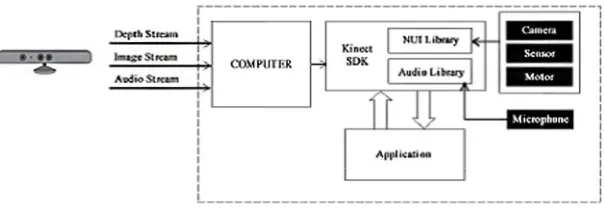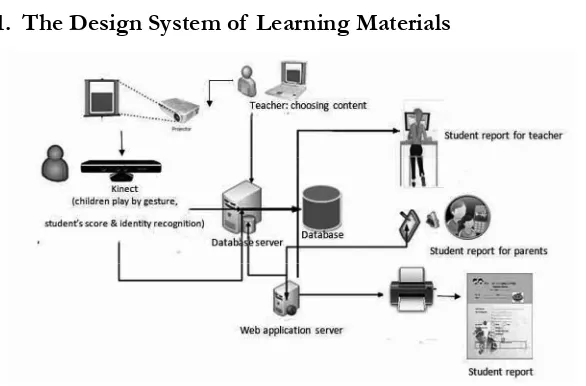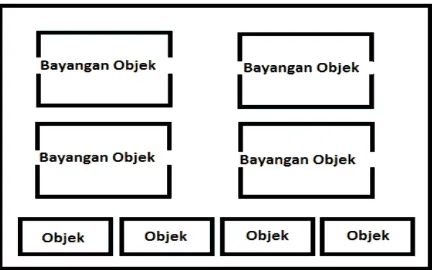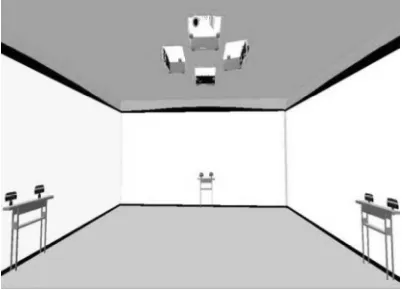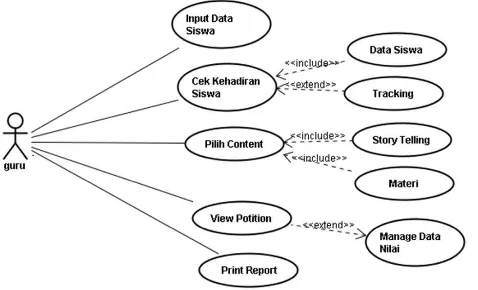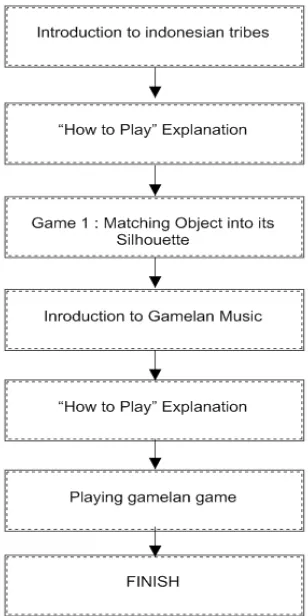DESIGNING AND IMPLEMENTING THE
EDUCATIONAL GAME INDONESIAN
TRIBES FOR THE KINDERGARTEN
STUDENTS
Pikir Wisnu Wijayanto 1, Yahdi Siradj2 1, 2 School of Applied Science at Telkom University
1 [email protected], 2 [email protected]
Abstract
This study is aimed at describing the educational game The In-donesian Tribes as multimedia application in the learning activities for the students in kindergarten. This multimedia application is de-signed to facilitate the students in order to improve their knowledge of tribes and cultures in Indonesia such as the traditional clothes, houses, dances in Indonesia, and the gamelan musical instruments. This application is equipped with a Kinect sensor technology to de-tect the external trigger such as speech and gesture recognition that will further encourage the liveliness; children are play while learning. It is in line with the characteristics of the kindergarten students who love to play and learn in their own imagination. The game is also completed with audio-visual animations in various contents, and interactive nature in terms of playing and learning activities with a simple description and instruction of the English language. The use of interactive contents in this application enables them to have some senses owned better and more effective, such as the senses of sight, hearing, and motorist functions. Also for teachers, it can increase the teaching creativity and create a good atmosphere of learning. In other words, this educational game can enrich the way children understand the essence of learning through playing.
1. INTRODUCTION
Currently, the use of technology in education led is develop-ing rapidly in term of graphics, charts, sound, real-time video and audio. It is also followed by the implementation of electronic games which become more entertaining and enjoyable for young and adult students. Among all the kinds of games, there is a special category that is called educational game, which has one goal beyond just en-tertainment, and that is education.
The use of multimedia application in teaching learning ac-tivities for the kindergarten students is also very familiar recently. This is due to the fact that educational game is appropriate with the characteristics of the young learners especially for kindergarten students who like to play and learn, as well as their imagination. By implementing it in teaching and learning process, a student has the opportunity to try out and modify much of what they see; the game is therefore a source of cognition for them. Therefore, it can enrich the way of students to understand the essence of learning through play. It allows them to better functioning of some sensory they owned, like the senses of sight, hearing, and motorist functions become more effective. Through the interactive content, the roles of multimedia can also increase the creativity and effectiveness of teachers in teaching, so it will create a good atmosphere of learning and become more interactive.
learning process activities.
In order to acquire the language in learning process, the kinder-garten students need not only to keep repeating the desired part of a target language, but also to be enjoyable every time. This is due to a fact that the children like things to be repeated, they like to know what is coming, and also enables them to participate with greater con dence and enjoy the game more. It is a necessary part of a language lesson and as an element of competition that is something they enjoy and makes them stay interested. For that reason, an edu-cational game can be as a tool used in a classroom on regular bases. This study aims at describing the educational game The In-donesian Tribes as multimedia application in the learning activities for the students in kindergarten. The design of multimedia applica-tion in this study is in an educaapplica-tional game format and completed with the introduction and understanding of several tribes and cul-tures in Indonesia. This multimedia application is designed to fa-cilitate the students in order to improve their knowledge of tribes and cultures in Indonesia such as the traditional clothes, houses, dances in Indonesia, and the gamelan musical instruments. This ap-plication is equipped with a Kinect sensor technology to detect the external trigger such as speech and gesture recognition that will fur-ther encourage the liveliness children play while learning. It is also completed with audio-visual animations in various contents, and interactive nature in terms of playing and learning activities with a simple description and instruction of the English language. It is in line with the characteristics of the kindergarten students who love to play and learn in their own imagination.
2. BACKGROUND LITERATURE 2.1. Educational game
and it has become main-stream for educators, governments, and parents.
Another de nition of educational game is an interactive play that teaches the goals, rules, problem-solving, adaptation, team work and social interaction. It give the fundamental needs of learning by providing - enjoyment, passionate involvement, structure, motivation, ego grati cation, adrenaline, creativity, so-cial interaction and emotion. Play has a deep biological, evolu-tionarily important, function, which has to do speci cally with learning. (Prensky, 2001:.6). Based on this understanding, an educational game is designed to provide information or embed the certain attitudes, for example to foster a spirit of together-ness and mutual cooperation. It also can provide cognitive and affective in learning experience.
2.2. Microsoft Kinect Sensor
TheKinect sensor has been developed and patented by
Mi-crosoft originally under a projectNatal since 2006. It is a hori-zontal bar connected to a small base with a motorized pivot and is designed to be positioned lengthwise above or below the video display. Microsoft created two competing teams to come up with the intended device: one working with aPrimeSense tech-nology and other working with techtech-nology developed by a com-pany called3DV. Eventually, the nal product has been named
Kinect for Xbox 360and was built on thePrimeSense sdepth
sens-ing technology.
Xbox One video game consoles and Windows PCs. The most important difference between Kinect for Xbox 360 andKinect for
Windowsis especially in an additional support of depth sensing
in near range that enables the sensor to see from 40 centimeters distance instead of 80 centimeters.
Initially, Kinect for Xbox 360 was developed for playing games withXbox game console. However, recently Kinect SDK (Software Development Kit) was released to use Kinect sensor in Windows applications. In addition, Kinect SDK comes with NUI (Natural User Interfaces) library. Communication of Kinect
sensor with the application is depicted in Figure 2.1. Owing to NUI Library, the following extractions are reachable by the ap-plication;
a. Image stream and depth stream
b. 20 different skeleton joints shown in Figure 2.2 c. Audio Stream
d. AdjustableKinect tilt.
Figure 1. Communication of Kinect sensor with application
and a motor mechanism to adjust theKinect tilt up and down. The device features an R=Red G=Green B=Blue (RGB) camera, depth sensor and multi-array microphone running pro-prietary software , which provide full-body 3D motion capture, facial recognition and voice recognition capabilities. Kinect uses a sensor and a light source to capture RGB data and data depth. The leftmost part Kinect is a source of infrared light. The light-emitting diode (LED) indicator next to it is a marker of the sen-sor can communicate with a computer. The next longer exists RGB camera is used to capture RGB data while the far right is an infrared camera is used to capture the data depth. RGB cameras capable of supporting a resolution of 1280 x 960 while infrared camera supports a maximum resolution of 640 x 480 DI bottom there are 4 sensor microphone for speech recogni-tion funcrecogni-tion.
3. FINDINGS: DESIGN SYSTEM AND IMPLEMENTA-TION
3.1. The Design System of Learning Materials
Figure 2. The Design System Learning Materials (Siradj, et.al, 2014)
a. The function of Kinect sensor is to capture the gesture based on the instruction that the student should do in the game. The data gesture from the student will be processed in a media server and matched with the requirements of the game. If the gesture is ap-propriate with the requirements, the student will get points and it is recorded in his or her activities.
b. Each student is using the identi cation form of quick reader (QR) code that af xed to their shoulders. Then, the webcam is placed on the oor and faced the ceiling. It will process the cap-tured data on the QR code and be matched with the database. The matching process will determine automatically the name of the student who was playing the game Indonesian Tribes. c. This system also can be used to record the daily presence of
student. The data presence and activity of children during game play will be collected by the web server and forwarded to the parents. Therefore, parents can know what their children do and increase the ability of children to read every day.
3.2. The Interfaces of the Educational Game Game Interfaces
Figure 3. Storyboard: Main Menu (Siradj, et.al, 2014)
On the main menu, the student can choose his/her favou-rite game to play by using the hand gestures, the student then moves beyond the mouse button (hover) and paused until the action button depressed. The next scene that appears will be depending on the selected button.
Figure 4. Storyboard: Game Scene (Siradj, et.al, 2014)
3.3. The Implementation of the Indonesian Tribes as a Multimedia Application
Figure 5. The Architecture System in Implementing the Program (Siradj, et.al, 2014)
In implementing the application of the Indonesian Tribes , the room is designed with four full multimedia projec-tors that are facing on the wall with 4Kinect sensors. The ideal size of room is 3 x 3 meters wide and can be possible used for 9 multi-players.
There are some parameters that affect the quality of games on infrastructure delivery as follows:
a. The resolution of the projector. The higher resolution of the projector, the image which is appeared on the wall can be seen clearer and bigger.
b. The lighting of the room. The directional of outdoor light should be made in order not to compete with the light from the projector.
Figure 6. Diagram of Activity (Siradj, et.al, 2014)
not too tired or bored. Before the game starts, there are several songs of the tribes of Indonesia appeared on the lists. The more frequently they played; they can memorize well the song. The game is made with the different level of dif culties, although it was not too signi cant to keep the spirit of a student in playing.
Figure 7.Use Case Diagram for User (Siradj, et.al, 2014)
There are some choices on the menu that can be selected by the students to start the game, such as; select the position, look at the content, choose the wall game and see the tempo-rary score. The process of selecting the position and choosing the wall game involves the webcam sensor assistance that deter-mines the coordinates and delivers the student at the centre of the wall where he/she plays the games.
In terms of teachers, some functions that are built; input student data, student attendance check, choose the content, see the position of the students, and print reports.
3.4. The Indonesian Tribes Game Education
This multimedia application is designed to facilitate the stu-dents in order to improve their knowledge of tribes and cultures in Indonesia. There are some system requirements as the target for users, such as the ability:
a. to see and observe
b. to explore and learn the introduction material of Indonesia tribes
c. to know the Indonesia tribes and gamelan musical instru-ments
d. to nish the game
e. to help the student learn independently and creatively f. to ease the teacher in delivering the material
Picture 1. Game Scene (Siradj, et.al, 2014)
cor-responding shadow. The scene is made as complete as possible in accordance with the national custom databases that exist in Indonesia.
There are some various contents in the game that are equipped with a Kinect sensor technology to detect the external trigger such as speech and gesture recognition that will further encourage the liveliness children play while learning, such as the traditional clothes, houses, dances in Indonesia, and the gamelan musical instruments. All those game are also completed with audio-visual animations.
Picture 2. The Traditional Clothes of Indonesia
Picture 3. The Traditional Houses of Indonesia
Picture 4. The Traditional Dances of Indonesia
and then continued with the introduction of gamelan game. In the introduction to gamelan game, students will be treated in advance about the history of the orchestra and how to play. Fur-thermore, the kindergarten students can play gamelan together.
Figure 9. The Gamelan Musical Instruments Game Sequence (Siradj, et.al, 2014)
4. CONCLUSION
REFERENCES
Adams, D.M. (1973). Simulation games: An approach to learning. Worthington, OH: C.A. Jones.
Aldrich, H.E., Ruef, M. (2006). Organizations evolving. London: Sage Publications: 16-60. Accessed at: http://fhs-bio-wiki.pb-works.com/w/page/24126934/What%20is%20Evolution on October 2nd, 2014.
Alexander, et.all. (1988). Teaching Reading. Glenview: Scott, Fortes-man and Company.
Anggani Sudono. (1988). Sumber Belajar dan Alat Permainan Untuk Pendidikan Usia Dini. Jakarta. Grasindo.
Arief S. Sadiman, et.all. (2009). Media Pendidikan, Pengertian, Pengem-bangan, dan Pemanfaatannya. Jakarta: Rajawali Press.
Arikunto Su Harsimi (1992). Pengelolaan Kelas dan Siswa Sebuah Pendekatan Evaluatif. Jakarta; Rajawali.
Borowich, Jerome N. (1996). Technical Communication and Its Applica-tion. California: Prentice Hall, Inc.
Carrol Ja. (1991). Centers for Early Learners Throughout the Year. Chart-age, Good Apple.
Darin E. Hartley. 2006.Selling e-Learning, American Society for Training and Development.
Depdiknas. (2004).Kurikulum 2004 Standar Kompetensi Taman
Kanak-kanak dan Roudlotul Athfal. Jakarta : Departemen Pendidikan
Nasional.
Harmer, Jerremy. (2001).The Practice of English Language Teaching 3rd
Edition.New York: Longman, Inc
Juwita. D. (2010). Perkembangan Fisik Motorik dan Bahasa. Surakarta: Universitas Muhammadiyah Surakarta.
Marsh, et.all. (2005). Digital Beginnings: Young Children s Use of Popu-lar Culture, Media and New Teachnologies. Shef eld: University of Shef ed. Accessed at: http://www.digitalbeginings.shef. ac.uk/ on October 2nd, 2014.
Microsoft. (2012). Kinect for Windows SDK 1.6 Programming Guide . Microsoft. Retrieved February 16, 2015.
Prensky, Marc. (2001). Fun, Play and Games: What Makes Games Engaging. Digital Game-Based Learning. McGraw-Hill. Ac-cessed at: http://www.marcprensky.com/writing/Pren-sky%20-%20Digital%20Game-Based%20Learning-Ch5.pdf on July 30th, 2016
Prodromou, L. (1992).Mixed Ability Classes. China: Macmillan Pub-lishers Ltd.
Siradj, Y, et.all. (2014). Designing and Implementing Knowing Indonesian Tribes Game in Future Kindergarten.Bandung: School of Electri-cal Engineering and Informatics, Bandung Institute of Tech-nology.
Wijayanto, P. W., and Siradj, Y. (2015). Designing the Educational Game The Indonesian Tribes for Kindergarten Students .
